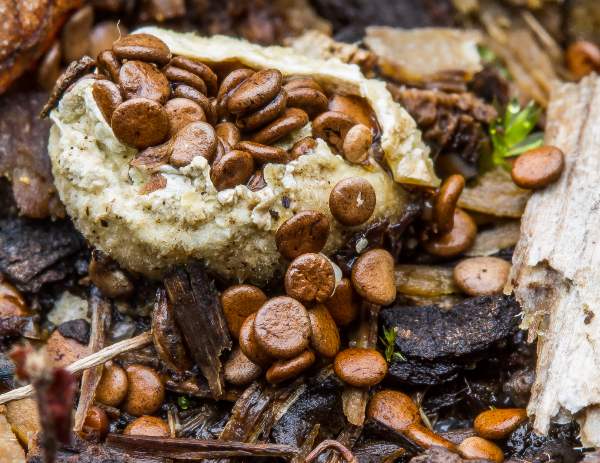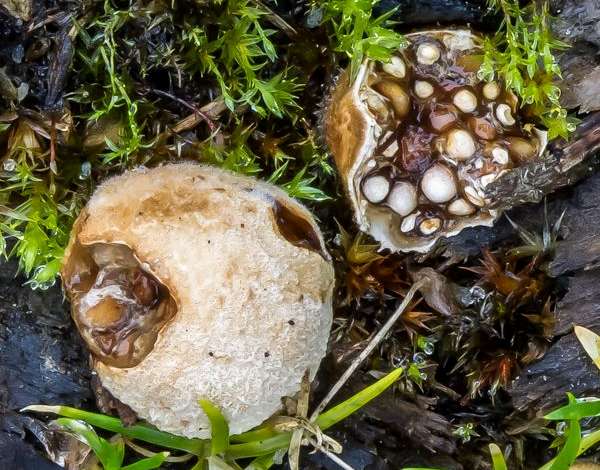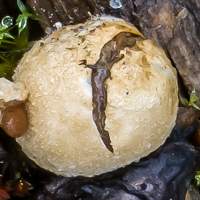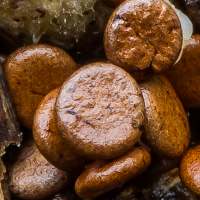Trees Birds Mammals Fish Amphibians Reptiles
Wild Algarve
Bookshop
Nidularia deformis (Batsch) Pers. - Pea-shaped Bird's Nest
Phylum: Basidiomycota - Class: Agaricomycetes - Order: Agaricales - Family: Agaricaceae
Distribution - Taxonomic History - Etymology - Culinary Notes - Identification - Reference Sources

Nidularia deformisis, one of several species of bird's-nest fungus, is distinguished by its chestnut-brown, vertically-squashed 'eggs', or peridioles as they are known in mycological circles. The fruitbodies grow on rotting wood or wood-rich debris in damp, shaded locations.

Distribution
A rare find in Britain and Ireland, these little fungi are known to occur in Scandinavia and other parts of Europe including Germany and France. This species is also recorded in North America, Australia and New Zealand.
Taxonomic history
This gasteromycete fungus was described in 1788 by German botanist Carl Ludwig Willdenow (1765 - 1812), who gave it the scientific name Cyathus deformis. The currently-accepted name Nidularia deformis dates from an 1813 publication by the Swedish mycologist Elias Magnus Fries.
Synonyms of Nidularia deformis include Cyathus deformis Willd., Granularia pisiformis Roth., Nidularia berkeleyi Massee, Nidularia confluens Fr., Nidularia farcta (Roth) Fr., Nidularia pisiformis (Roth) Tul. & C. Tul., and Nidularia radicata Fr.& Nordholm.
Etymology
The generic name Nidularia comes from the Latin Nidulus, meaning 'little nest'. The specific epithet deformis is a reference to the squashed (misshapen or deformed) shape of the 'eggs'.
Identification guide
 |
Fruitbody (Peridium)
Subglobose, typically 5 to 10mm diameter, cream to cinnamon-buff, thin-skinned and with a felty or scaly surface texture; filled with a gelatinous mass within which the peridioles develop; case rupturing irregularly when the peridioles reach maturity. |
 |
Peridioles
Individual 'eggs' are round-edged biscuit-like discs 0,.5 to 2mm across and up to 0.3mm thick. The surface of an egg is chestnut brown, while its interior is white.
Each fruitbody contains a large and very variable number of peridioles, which are not attached to the base of the cup. |
| |
Spores
Broadly ellipsoidal smooth,6-10 x 4-7µm; inamyoid.
Spore colour
White. |
Odour/taste |
Not significant. |
Habitat & Ecological role |
Mainly found on wet rotting wood, wood-chip mulch and permanently-damp sawdust. |
Season |
May to November in Britain and Ireland. |
Similar species |
Cyathus and Crucibulum species have regularly-opening peridia, and their peridioles are much more globose. |
Culinary Notes
These fungi are reported to be inedible.
Reference Sources
, Pat O'Reilly, 2016.
Dictionary of the Fungi; Paul M. Kirk, Paul F. Cannon, David W. Minter and J. A. Stalpers; CABI, 2008
Taxonomic history and synonym information on these pages is drawn from many sources but in particular from the British Mycological Society's GB Checklist of Fungi.
Acknowledgements
This page includes pictures kindly contributed by James Langiewicz.
Top of page...
Fascinated by Fungi. Back by popular demand, Pat O'Reilly's best-selling 450-page hardback book is available now. The latest second edition was republished with a sparkling new cover design in September 2022 by Coch-y-Bonddu Books. Full details and copies are available from the publisher's online bookshop...